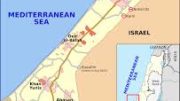Like it or not, since 1948 the prime aggressors in the Arab/Israeli conflict have been Arabs. They tried to destroy the new Israeli state when it was being created and refused a partition agreement by the international community in the form of the United Nations which would have given the Arabs a considerable amount of land, in their own state, next to Israel. Israel has been attacked many times by Arab nations, starting in 1948, who were beaten back at the cost of a considerable number of Israeli military lives. Since then Arabs have promised peace with Israel but have never, ever delivered, they talk peace but prepare for war.
One result of the various wars that Israel has fought with Arab aggressors was that Israel gained control of the Gaza strip, along with the Sinai desert, the West Bank and East Jerusalem. Because the Arabs lost territory as a result of their aggression, they have no right to whine that they have lost this land. The Arabs started wars and encouraged terrorism and lost, so they need to pay the price for this aggression.
However the desire for peace among Israelis is very strong and I believe much stronger than the desire for peace among Arabs. One result of this Israeli desire for peace was the growth of the idea of ‘land for peace’. This theory posed the idea that if the Arabs had some of the land that was captured during the wars of Arab aggression then they would be more likely to live in peace with the Israelis.
In an effort to buy peace with the Arabs, in August 2005 the Israeli government withdrew from the Gaza Strip and forcibly evacuated all Jewish residents of Gaza and handed it over to the ‘Palestinians’. This has been shown to be a huge mistake, because what happened was not the creation of a peaceful Arab-dominated Gaza strip living in peace with their Israeli neighbours, but the conversion of Gaza into a terror base from which attacks against Israel have been launched.
When Israel controlled the Gaza strip, it was a place where agricultural industries flourished and this benefited not only the Jewish inhabitants but also many of the Arab ones who worked in these industries. The withdrawal from Gaza and the eviction of the Jewish residents of Gush Katif was brutal and has been proved subsequently by later events to be an utterly pointless action. The Arabs got the land of the Gaza strip but have not kept their side of the bargain and made peace.
The Jewish people have been subjected to many pogroms and expulsions from many places over the last two millennia, but the expulsion of the Jewish residents of Gaza was different, this time those doing the expelling were not Cossacks or Communists or Nazis or soldiers of an English King, but fellow Jews in Israeli Defence Force uniforms.
The Jewish residents of Gaza paid a terrible price for a peace that has been proved to be just an illusion of peace. The world can now see that this was a price that was not worth paying. Jews should never have been expelled from the land where the Biblical patriarch Abraham once lived.
The Arabs have shown by their actions that they do not deserve to control the Gaza strip because they have taken the land and have not used it for positive purposes. They have used it to fire rockets at nursery schools, civilians and Israeli soldiers, the Arabs cannot be trusted to live in peace with others and maybe it is time for Israel to take back Gaza and make it a place of peace again.
Here is a wonderful article from Michael Freund of the Jerusalem Post about Gaza’s past, Gaza’s present and the future of those Jewish Gazans who were so unjustly and pointlessly expelled from Gaza.
The Jerusalem Post said:
Thirty-seven years ago today on the Hebrew calendar, on the 22nd of Tevet, an Israeli prime minister took part in an important ceremony amid the sand dunes of Gaza.
It was on that day that Nezer Hazani, the first Gazan Jewish village in modern times, was formally established when a military outpost was transformed into a civilian community.
“This is a great day for the State of Israel and Jewish settlement,” the premier said, adding that, “It is a day that symbolizes the fortification of our presence in this area, which since the Six Day War has become an integral part of the state and its security.”
At the culmination of the celebration, the prime minister himself took a mezuzah and personally affixed it on the doorpost of one of the homes, underlining Israel’s commitment to the reestablishment of ancient Jewish life in Gaza.
Believe it or not, but that premier was none other than Yitzhak Rabin, the slain saint of Israel’s peace movement.
And, no less ironic, it was the hawkish Ariel Sharon who oversaw the bulldozing of Nezer Hazani just 28 years later during the August 2005 ‘disengagement’ from Gush Katif.
The memory of the disengagement, and the pain that it brought to thousands of Jews who were forced out of their homes, is still very real, as real as the heavy price that Israel continues to pay for abandoning the Gaza Strip to our enemies.
Fortunately, these critical events in the history of the modern State of Israel will be commemorated in hundreds of schools throughout the country today in a remarkable initiative known as Gush Katif Education Day.
Launched by the Gush Katif Committee and the Gush Katif and Northern Samaria Heritage Center in 2007, this important event aims “to remind students of the past 35 years of Gush Katif’s existence and not just focus on its destruction.” It is a voluntary program which has the approval of Israel’s Education Ministry, and has come to encompass both secular and religious institutions.
This says a lot about how remarkable the Jews who formerly lived in Gush Katif are. Despite their bitter experience, despite being torn away from their homes by their fellow Jews, they have chosen to respond neither in anger nor in vindictiveness.
Instead, they are focusing on spreading a positive educational message, one that “celebrates religious faith, Zionism, settlements and the Israeli state.”
This is a day on which to reflect on the heroism of Jewish pioneers, who strove to make the desert of Gaza bloom, both agriculturally and spiritually.
And it is also an appropriate time to recall Gaza’s rich and vivid Jewish history, which stretches back to the beginnings of our people.
Indeed, two of Israel’s founding fathers, Abraham and Isaac, sojourned in Gaza. In the book of Genesis (20:1), the Torah says that Abraham “lived in Gerar,” a city located in Gaza.
Later, when there was a famine in the land and Isaac thought of leaving for Egypt, God stopped him in Gerar, and told him explicitly: “Dwell in this land, and I will be with you, and I will bless you; for unto you and unto thy seed will I give all these lands” (Genesis 26:3).
Isaac remained in Gaza, and it is precisely there – in Gaza, of all places! – that God saw fit to reaffirm His promise regarding the Jewish people’s right to the entire Land of Israel.
After the Exodus from Egypt, when the Jews reached the Promised Land, Gaza was given to the Tribe of Judah (see Joshua 15:47) as a share of its eternal inheritance, and according to the Book of Judges (1:18), “Judah captured Gaza and its border.”
During the Talmudic era, Gaza was home to a large Jewish population. In the fourth century CE, some 1,600 years before the establishment of the PLO, Gaza served as the primary port of commerce for the Jews of the Holy Land.
Later, in the Middle Ages, Gaza was home to prominent rabbis, including Rabbi Yisrael Najara, author of the popular Sabbath hymn “Kah Ribon Olam,” and the great Kabbalist Rabbi Avraham Azoulai.
Indeed, Rabbi Yaakov Emden ruled that, “Gaza and its environs are absolutely considered part of the Land of Israel, without a doubt.”
“There is no doubt,” he added, “that it is a mitzvah to live there, as in any part of the Land of Israel.”
Even though Jews have been expelled from Gaza seven times over the past 2,000 years, they have nonetheless returned to resettle it with increased fortitude and vigor. In 61 CE, the Romans evicted the Jews from Gaza, as did the Crusaders, Napoleon, the Ottoman Turks, the British army in 1929 and the Egyptians in 1948.
And then, in 2005, Israel’s own government joined the ignominious list of those who sought to bring about an end to the Jewish presence in Gaza.”
Read the rest here:
http://www.jpost.com/Opinion/Columnists/Fundamentally-Freund-Gush-Katif-Past-and-future-339066





